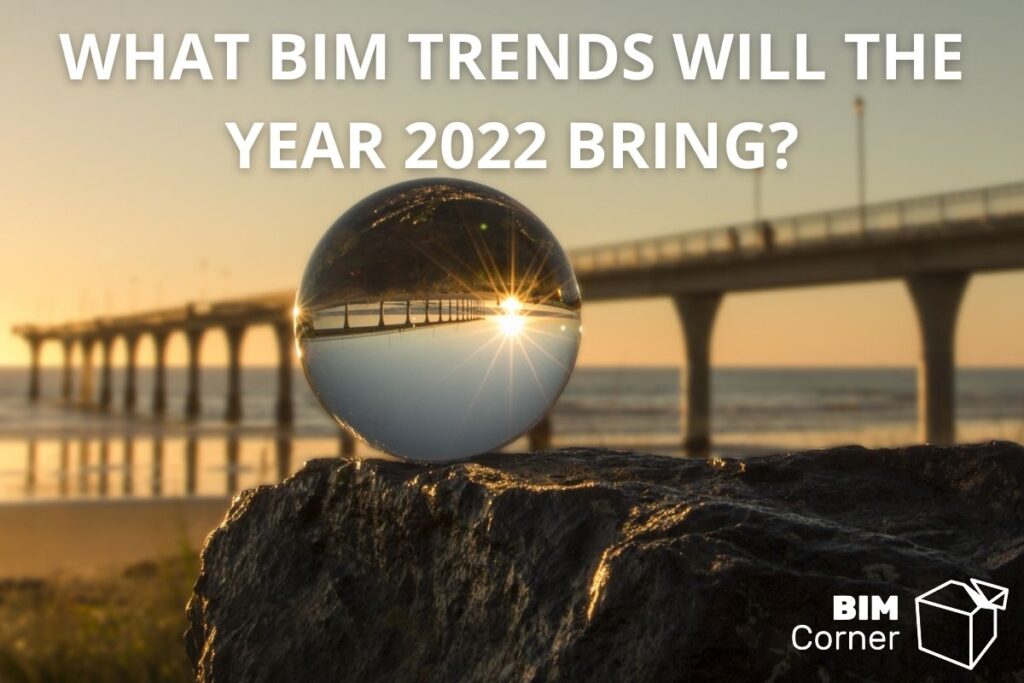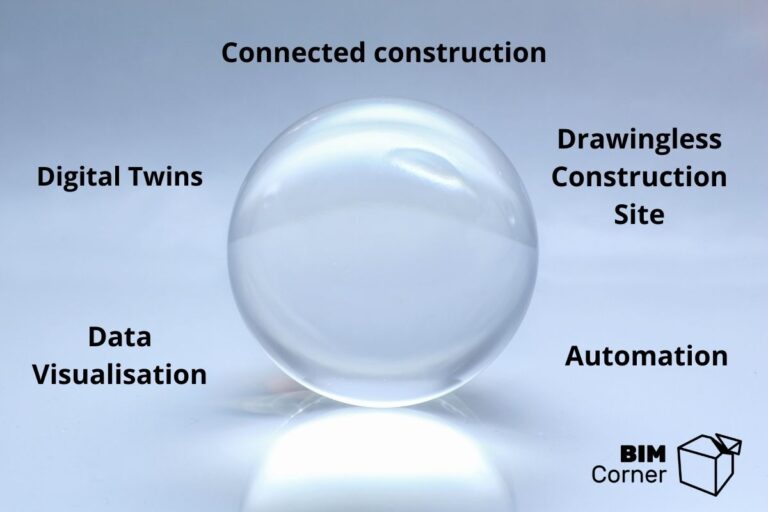We’ve learned to live with Covid and we’ve learned to work from our homes. Constructions were moving forward which means that contractors were able to adapt hygienic and safety measures to the sites and continue working.
That was 2021. What brings us 2022? At the beginning of the year, I like to read and watch about different forecasts: economical, political or what might happen in the AEC branch. There are challenges and opportunities. We shared a few of such reports through our newsletter (if you are still not a subscriber, you find the box to your right or under the text). I was searching for some prognosis for the BIM market, but I haven’t found much information. So I thought I would create such a list myself. Before I ask you to share in the comments what do you think are the incoming trends for 2022, let me first share with you my point of view.
Table of Contents
Connected construction
This sounds like another hot term that we have loads in our branch. But what I mean by this is enhancing digital collaboration.
Construction teams are spread and will continue to be spread for at least some time. Maybe a majority of this year? Maybe longer? And working from home requires we collaborate better using digital tools. By this, I don’t mean video meetings platform.
Designers are seldom on the site. Same for Building Owners. Even Construction Managers might be rotating so that no more than 50% of the staff is on-site at the same time to avoid work downtime.
That creates a need for better digital collaboration and I think this can be a huge BIM Trend for the incoming year. Design meetings, document approvals, contract negotiations, site inspections. This will all happen in the cloud. CDE will have to be more powerful, more user-friendly and more effective. I think we will see some new solutions in this field. And by this, I mean both software and implemented processes. Or maybe even some changes to national standards lowering the bureaucracy and paperwork?
Drawingless construction site
Enhanced digital collaboration might lead to enhanced usage of the models on-site. If we are creating a model that resides in the cloud, why not take both the model and the cloud on-site? Drop the drawings and adjust building processes to digital delivery.
I see this may come from two sides. The first one is the Building Owner who wants to raise the quality of his building by requiring a digital twin. Delivery of better models might lead to decisions to build based on them. That enhances the work effectiveness and quality of the building at the same time aligning digital building with the physical one.
The other side is the General Contractor. He may want to increase effectiveness and save time so that he decides to use the full potential of BIM technology on site. This means for example using tablets on-site, digital checklists in the models or maybe even off-site prefabrication from the model. Some contractors are already doing this and I am always impressed with what they can take out from the model.
This is already happening on some of the construction sites. If you would like to hear how we have set up drawingless construction site at New Stavanger University Hospital, you have a great opportunity! February 2nd at 11.00 CEST, I will hold a presentation during an online conference – Festival of Digital Construction. The conference is free to attend and you can register by clicking here.
I think this will be a BIM trend for 2022 and will happen on a wider scale now as there are more and better software solutions. The path is already laid down by other projects so this is where others can draw the knowledge from.
Automation
Those two previous topics influence the next one: automation.
There is a general tendency in the branch to leverage the quality of the models. Tools are the same, so there is no magic: to deliver better quality, you have to work faster and better. Since projects’ margins are still very low, many companies search for competitive advantage in automating their workflows.
I think this is going to be bigger and more popular this year. Starting from broader usage of Visual Programming, through easy scripting and ending on Robotic Processes Automation.
There aren’t many coders in our branch. Furthermore, the software we use don’t cooperate with one another very well. APIs are residual, open formats are hard to edit. Besides, we have a lot of manual and repetitive tasks to perform. The bigger the project the more such tasks. And those can be solved with RPA and I see huge potential here. This is already in use on some bigger projects. I think it will scale down since the threshold is relatively low. Software is rather easy to learn and for example Microsoft has it in it’s Power Platform.
We have already mentioned RPA on our blog, for example here.
Scripting requires a higher threshold – somebody on the projects has to know how to code, or the project may want to hire a developer. But it pays off. I see increasingly more examples of project-specific scripts or add-ons. If such a script can save the project team even 20 hours a week and this is repeated over 3 or more years of the design phase, then this is a huge return on investment, especially with pressure for rising salaries due to global high inflation rates.
Yet another reason why some companies may bet on automation is a challenge with talent acquisition. Many executive leaders see this as one of the biggest challenges for AEC for 2022. And to make this impact less severe, some firms may focus more on automation to deliver the same quality using less workforce.
Data Visualisation
Our models contain more and more data, therefore, we have to visualise the data to understand it and avoid data overflow.
PowerBI took the branch with a storm in 2019 and have continued to gain popularity since then. I predict that this solution is going to be used on various ranges of projects – from large to small.
Here the threshold also doesn’t seem to be very high – every Office365 user has access to a free version of PowerBI and there are loads of training materials online. Construction software are also getting better at providing links to PowerBI.
Digital Twins
Digital Twins became a buzzword in 2020. Looked like everybody wanted to create or have one. And I was looking at it rather reluctantly expecting it to be another term coined by creative marketers. However, after seeing this term in a few contracts with an explanation of what Building Owner understands as his Digital Twin I began to lean towards it being something more.
Digital Twins are still gaining popularity and losing its “buzziness” as Building Owners begin to require an actual as-built model equivalent to the real building, together with all interconnected data and operational documents. This, plus the advancement of FM software that enables for management of Digital Twins make it in my mind one of the BIM trends for this year.










Nice Article and very informative. I am doing some academic research in BIM and I have come across really nice articles on your platform. you have won a disciple.
Thanks, cheers! 🙂